Uncategorized
Crypto Daybook Americas: Turmoil Across The Pond as Bitcoin Defends $93K After $300B Wipeout

By James Van Straten (All times ET unless indicated otherwise)
The total cryptocurrency industry is now under $3.2 trillion in market capitalization, as over $300 billion has been wiped out since Jan. 6, taking away all early gains for the year, according to the TradingView metric TOTAL. As a result, bitcoin (BTC) is now hovering above $93,000 but has been making a succession of higher lows starting from Dec. 30.
Adding to the bearish sentiment, market is digesting the unconfirmed reports from DB News which suggest that the U.S. government has been given the green light to liquidate as much as 69,370 BTC ($6.5B) from the Silk Road seizure. This makes the political theatre between the outgoing and incoming U.S. administrations even more intriguing, as president-elect Donald Trump, who is just few days away from being sworn in on Jan. 20, vowed not to sell any of the bitcoin held by U.S. authorities, which, according to Glassnode data, amounts to 187,236 BTC.
The onslaught in the crypto industry stems from an extremely high DXY index, above 109, which measures the value of the U.S. Dollar relative to a weighted basket of major foreign currencies. In addition, for a brief moment, the U.S. treasury yields were rising before retreating slightly yesterday. The benchmark for 10-year yield was as high as 4.73%.
The inflation concerns that paddled the selloff in the broader market is picking up alongside growth expectations, LondonCryptoClub told CoinDesk. «The combination of rising growth and inflation expectations alongside rising term premia as the market struggles to digest huge treasury supply to fund these deficits is pushing U.S. yields higher, which is dragging global yields higher, excluding China.»
However, turmoil is occurring across the pond in the U.K., with gilt yields continuing to march higher this morning. Records were set today, as the 30-year U.K. jumped to almost 5.45%, the highest level since 1998. While the benchmark U.K. 10-year challenged 4.95%, the highest since 2008, the treasury was forced to intervene in the market to calm investors, according to reports from The Telegraph.
LondonCryptoClub mentioned the key reasons for the turmoil, «the U.K. is under pressure after a disastrous budget which has increased borrowing needs with little to no positive growth impact, exacerbating the negative debt/GDP dynamics and driving a larger fiscal deficit.»
As a result, the not-so-Great British pound, falling yet again, is now 1.22 against the dollar, the lowest level since November 2023, and has fallen almost 4% in the past month.
Today, Jan. 9, is declared a mourning day in the U.S. to remember the death of former President Jimmy Carter. Therefore, the stock market will be closed. So, all eyes will be turning to the jobs report on Friday. The market is in a good news is bad news scenario as rate cuts for 2025 get pushed back with only one rate cut expected for 2025.
A strong jobs report could remove this rate cut, with unemployment expected to come in at 4.2%, while nonfarm payroll is estimated at 154,000. A hot jobs print could send the dollar to 110, putting further pressure on risk-assets.
Stay alert!
What to Watch
Crypto
Jan. 9, 1:00 a.m.: Cronos (CRO) zkEVM mainnet upgrades to ZKsync’s latest release.
Jan. 12, 10:30 p.m.: Binance will halt Fantom token (FTM) deposits and withdrawals and delist all FTM trading pairs. FTM tokens will be swapped for S tokens at a 1:1 ratio.
Jan. 15: Derive (DRV) to create and distribute new tokens in token generation event.
Jan. 15: Mintlayer version 1.0.0 release. The mainnet upgrade introduces atomic swaps, enabling native BTC cross-chain swaps.
Jan. 16, 3:00 a.m.: Trading for the Sonic token (S) is set to start on Binance, featuring pairs like S/USDT, S/BTC, and S/BNB.
Macro
Jan. 10, 8:30 a.m.: The U.S. Bureau of Labor Statistics (BLS) releases December 2024’s Employment Situation Summary report.
Nonfarm payrolls Est. 154K vs. Prev. 227K.
Unemployment rate Est. 4.2% vs Prev. 4.2%.
Jan. 10, 10:00 a.m.: The University of Michigan releases January’s Michigan Consumer Sentiment (Preliminary). Est. 73.8 vs. Prev. 74.0.
Jan. 14, 8:30 a.m.: The U.S. Bureau of Labor Statistics (BLS) releases December 2024’s PPI data.
PPI MoM Prev. 0.4%.
Core PPI MoM Prev. 0.2%.
Core PPI YoY Prev. 3.4%.
PPI YoY Prev. 3%.
Jan. 14, 8:55 a.m.: U.S. Redbook YoY for the week ending on Jan. 11. Prev. 6.8%.
Jan. 15, 8:30 a.m.: The U.S. Bureau of Labor Statistics (BLS) releases December 2024’s Consumer Price Index Summary.
Core Inflation Rate MoM Prev. 0.3%.
Core Inflation Rate YoY Prev. 3.3%.
Inflation Rate MoM Prev. 0.3%.
Inflation Rate YoY Prev. 2.7%.
Jan. 16, 2:00 a.m.: The U.K.’s Office for National Statistics November 2024’s GDP estimate.
GDP MoM Prev. -0.1%
GDP YoY Prev. 1.3%.
Jan. 16, 8:30 a.m.: The U.S. Department of Labor releases the Unemployment Insurance Weekly Claims Report for the week ending on Jan. 11. Initial Jobless Claims Prev. 201K.
Token Events
Governance votes & calls
Gitcoin DAO started discussions on the launch of Allo.Capital, an entity focused on building tools for on-chain capital allocation.
Compound DAO is discussing the creation of a New Chains Business Unit to expand into other blockchains.
Unlocks
Jan. 11: Aptos to unlock 1.13% of its APT circulating supply, worth $98.85 million.
Jan. 12: Axie Infinity to unlock 1.45% of its circulating supply, worth $14.08 million.
Jan. 14: Arbitrum to unlock 0.93% of its circulating supply, worth $70.65 million.
Token Launches
Jan. 10: Lava Network (LAVA) to be listed on KuCoin and Bybit at 5 a.m.
Jan. 10: Bybit to delist FTM (FTM) at 5 a.m..
Conferences:
Day 4 of 14: Starknet, an Ethereum layer 2, is holding its Winter Hackathon (online).
Jan. 13-24: Swiss WEB3FEST Winter Edition 2025 (Zug, Zurich, St. Moritz, Davos)
Jan. 17: Unchained: Blockchain Business Forum 2025 (Los Angeles)
Jan. 18: BitcoinDay (Naples, Florida)
Jan. 20-24: World Economic Forum Annual Meeting (Davos-Klosters, Switzerland)
Jan. 21: Frankfurt Tokenization Conference 2025
Jan. 25-26: Catstanbul 2025 (Istanbul). The first community conference for Jupiter, a decentralized exchange (DEX) aggregator built on Solana.
Jan 30-31: Plan B Forum (San Salvador, El Salvador)
Feb. 3: Digital Assets Forum (London)
Feb. 18-20: Consensus Hong Kong
Token Talk
By Shaurya Malwa
A parody token just got its own parody.
AI Agents upstart ai16z, a platform mimicking venture fund a16z that uses AI to manage user funds, saw a mockery of its token raffle among smallcap speculators in the past day, running to a peak of $130 million market capitalization as of European morning hours.
Where ai16z tried to blend AI with investment, LLM — short for “Large Language Model” laughs at the very concept, suggesting that if AI can be anything, it can certainly be a meme with no real utility.

X users were quick to dub LLM as the «McDonald’s version of $ai16z,» mixing fast food with AI, creating a narrative where the only intelligence was in the marketing.
It has no inherent utility or technological backing; its value is purely speculative and community-driven, based on the meme’s popularity and the humor it brings to the crypto conversation.
AI Agent projects virtuals (VIRTUALS), ai16z (AI16Z) and the broader category are down more than 20% since peak on average in the past weeks amid criticism of their claimed AI models, as a CoinDesk analysis previously noted.
Derivatives Positioning
The annualized one-month basis in BTC and ETH CME futures has retreated to 6%-7%, the lowest since the election day. The positioning continues to moderate, with ETH open interest dropping to a one-month low of $2.9 billion, according to data source Amberdata.
Annualized funding rates in perpetual futures tied to large cap tokens now hover at around 5%, down significant from last month’s excessively bullish 80% to 100%. However, the OI-normalized CVD continues to signal net selling pressure in the market.
In options market, front-end skews now show bias for BTC and ETH puts, but longer duration continue to reflect a bullish bias.
Notable block trades include a large short trade in the BTC $55K put expiring on March 29. In ETH, traders shorted calls at strikes $4,800, $5,500 and $6,000.
Market Movements:
BTC is down 1.24% from 4 p.m. ET Tuesday to $93,307.05 (24hrs: -1.8%)
ETH is up 0.23% at $3,307.13 (24hrs: -1.15%)
CoinDesk 20 is down 1.18% to 3,954.73 (24hrs: -2.28%)
Ether staking yield is up 1 bp to 3.15%
BTC funding rate is at 0.0061% (6.66% annualized) on Binance
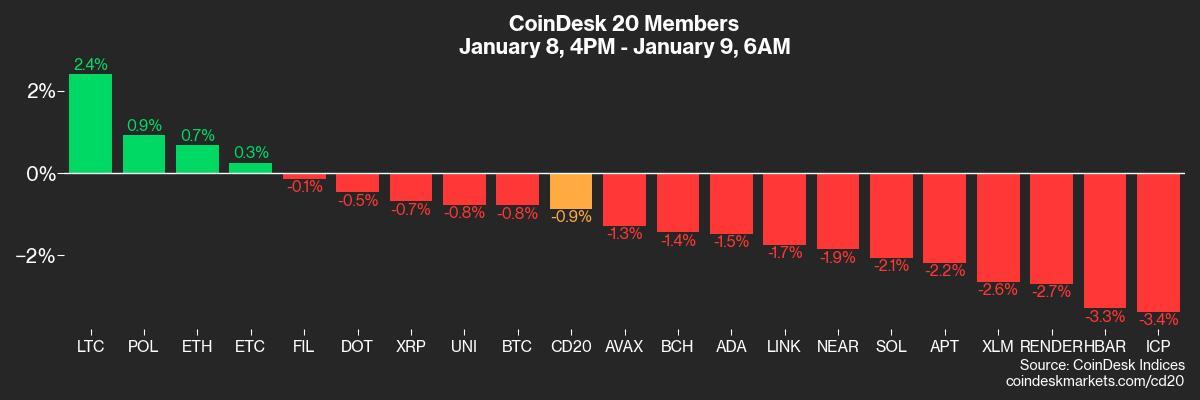
DXY is up unchanged at 109.19
Gold is up 0.72% at $2,683.8/oz
Silver is up 1.71% to $30.86/oz
Nikkei 225 closed -0.94% at 39,605.09
Hang Seng closed -0.2% at 19,240.89
FTSE is up 0.63% at 8,303.24
Euro Stoxx 50 is unchanged at 4,997.63
DJIA closed +0.25% to 42,635.20
S&P 500 closed +0.16% at 5,918.25
Nasdaq closed unchanged at 19,478.88
S&P/TSX Composite Index closed +0.49% at 25,051.70
S&P 40 Latin America closed -0.87% at 2,204.98
U.S. 10-year Treasury is down 2 bps at 4.68%
E-mini S&P 500 futures are down 0.1% to 5,953.0
E-mini Nasdaq-100 futures are down 0.18% at 21,323.00
E-mini Dow Jones Industrial Average Index futures are unchanged at 42,874.00
Bitcoin Stats:
BTC Dominance: 57.85
Ethereum to bitcoin ratio: 0.035
Hashrate (seven-day moving average): 785 EH/s
Hashprice (spot): $55.7
Total Fees: 7.57 BTC/ / $722,439
CME Futures Open Interest: 176,215 BTC
BTC priced in gold: 34.8 oz
BTC vs gold market cap: 9.90%
Basket Performance
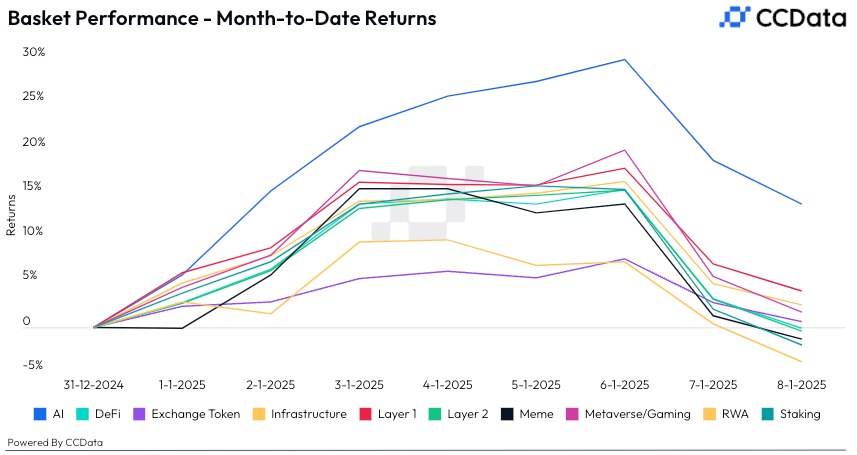
Technical Analysis
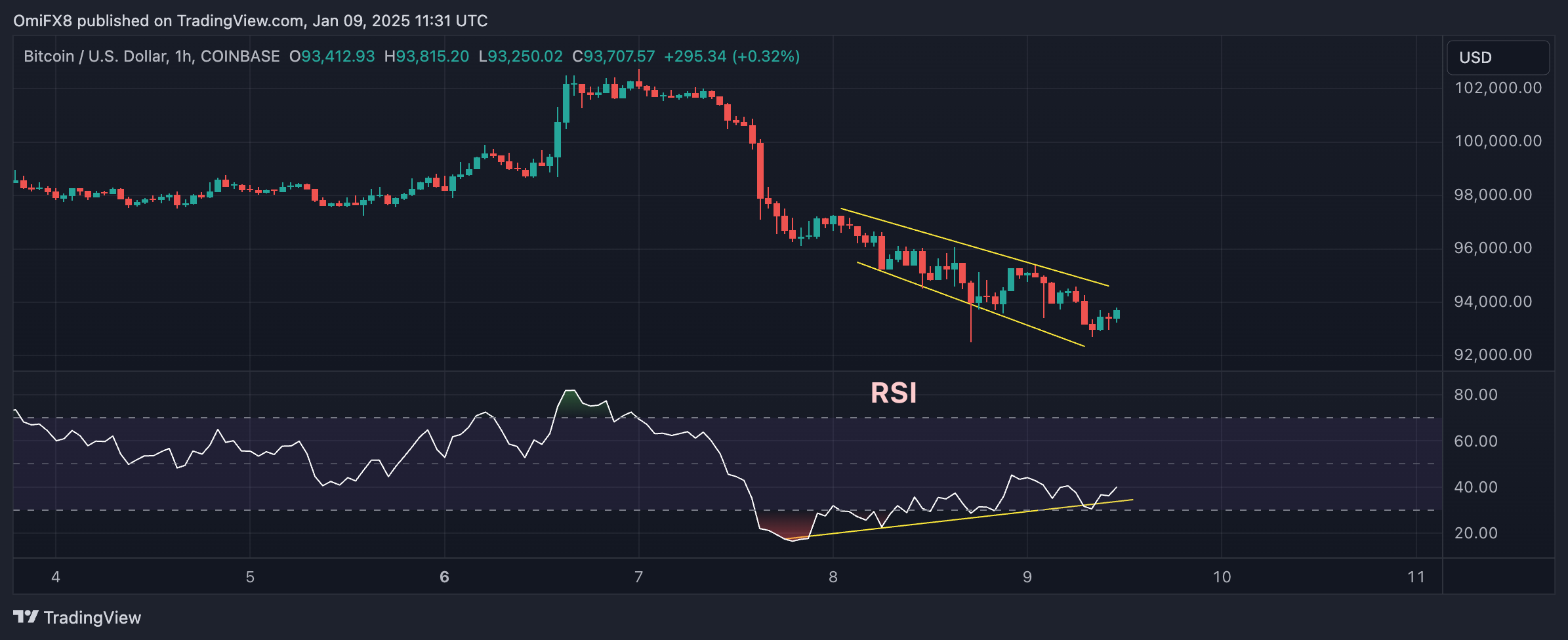
The chart shows BTC’s downward momentum is weakening.
While prices continue to chalk out lower highs, the momentum oscillator RSI is now moving in the opposite direction, diverging bullishly to signal a potential price bounce ahead.
Crypto Equities
MicroStrategy (MSTR): closed on Wednesday at $331.7 (-2.85%%), up 0.99% at $335.00 in pre-market.
Coinbase Global (COIN): closed at $260.01 (-1.63%), up 0.55% at $261.45 in pre-market.
Galaxy Digital Holdings (GLXY): closed at C$27.62 (-2.23%)
MARA Holdings (MARA): closed at $18.34 (-3.84%), up 0.11% at $18.36
in pre-market.
Riot Platforms (RIOT): closed at $12.02 (-3.14%), unchanged in pre-market.
Core Scientific (CORZ): closed at $14.05 (-0.5%), up 0.36% at $14.10 in pre-market.
CleanSpark (CLSK): closed at $10.09 (-5.79%), unchanged in pre-market.
CoinShares Valkyrie Bitcoin Miners ETF (WGMI): closed at $23.15 (-4.93%), down 1.08% at $22.90 in pre-market.
Semler Scientific (SMLR): closed at $50.19 (-9.14%), unchanged in pre-market.
Exodus Movement (EXOD): closed at $37.78 (-3.89%), up 0.21% at $37.86 in pre-market.
ETF Flows
Spot BTC ETFs:
Daily net flow: -$568.8 million
Cumulative net flows: $36.37 billion
Total BTC holdings ~ 1.140 million.
Spot ETH ETFs
Daily net flow: -$159.4 million
Cumulative net flows: $2.52 billion
Total ETH holdings ~ 3.627 million.
Source: Farside Investors, as of Jan. 8.
Overnight Flows
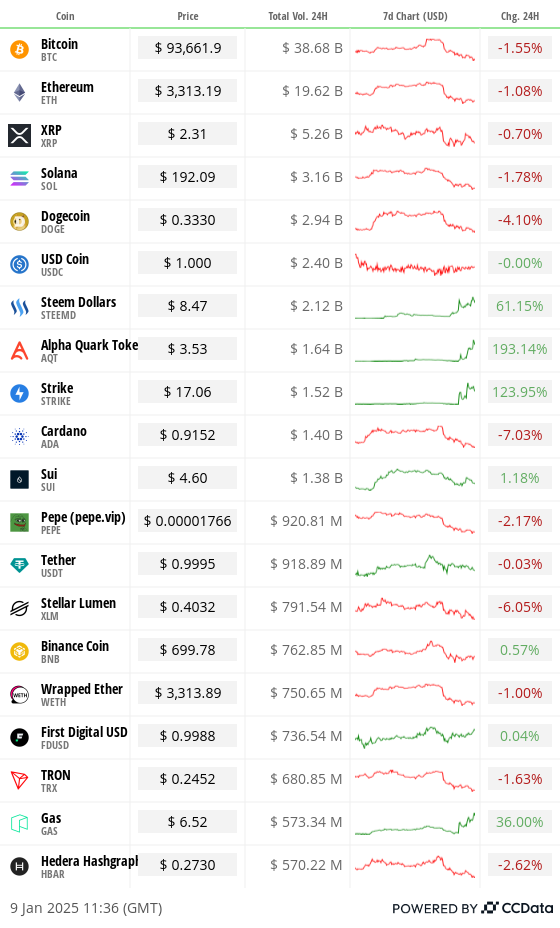
Chart of the Day
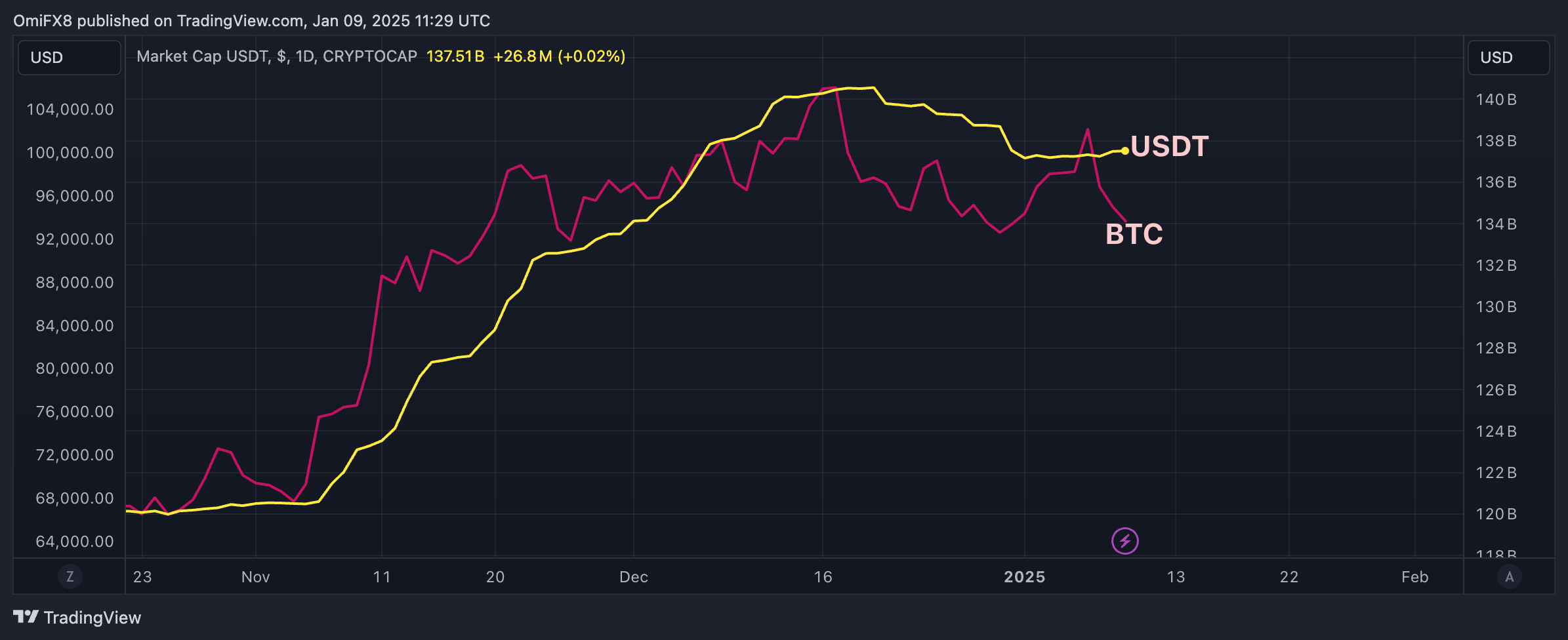
The MiCA-led decline in tether’s (USDT) market capitalization has stalled.
So, the ongoing decline in BTC may lose momentum. USDT, the world’s largest dollar-pegged cryptocurrency is widely used to fund crypto purchases.
While You Were Sleeping
Bitcoin ETFs Suffer $582M Net Outflow, Second-Highest Tally Ever (CoinDesk): Bitcoin and ether ETFs saw $582M and $159M in outflows Wednesday as the Fed’s December FOMC meeting minutes noted inflation risks from Trump’s policies and a possible slowdown in rate cuts.
XRP May Surge 40% As ‘Trump Effect’ Boosts Ripple Sentiment (CoinDesk): XRP, up 300% since November amid optimism for Trump’s crypto-friendly policies, could see another 40% surge as technical analysis highlights a bullish breakout from its descending triangle pattern.
Bitfinex Relocates Derivatives Services to El Salvador (The Block): Bitfinex Derivatives is relocating to El Salvador after obtaining its second license to operate under the nation’s crypto-friendly framework, allowing it to enhance its services and strengthen its regional presence.
Bond Market Selloff Jolts Global Investors As Trump Worries Grow (Reuters): A global bond price drop on Wednesday pushed yields to multi-year highs in the U.S., U.K., and Eurozone, driven by inflation risks, heavy bond issuance, and concerns about Trump’s tariff threats.
China Consumer Prices Weaken Further, Adding to Deflation Worries (Bloomberg): China’s inflation slowed for a fourth month in December, with CPI up just 0.1% year-on-year, the National Bureau of Statistics reported, highlighting deflation risks amid global inflation pressures.
Asia’s Central Banks Face a Formidable Challenge: An Ascendant U.S. Dollar (CNBC): The U.S. dollar’s post-election rally has devalued the currencies of Japan, China, South Korea, and India, raising import costs for these nations and complicating their central banks’ economic strategies.
In the Ether
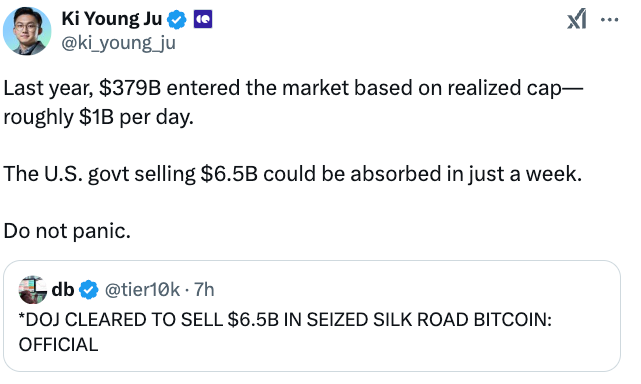
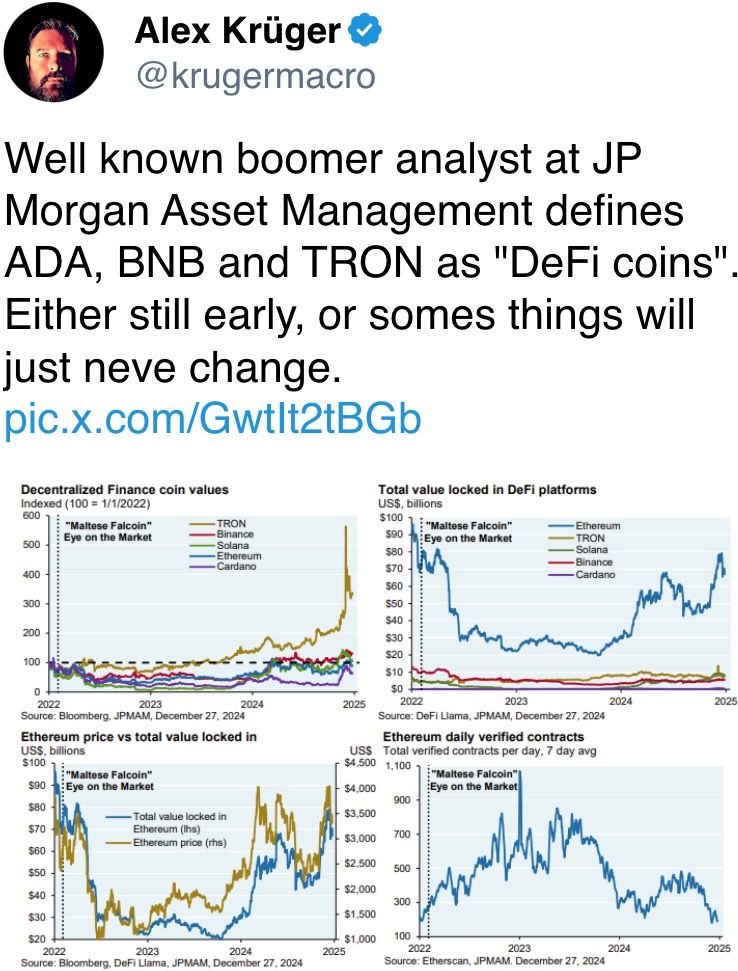

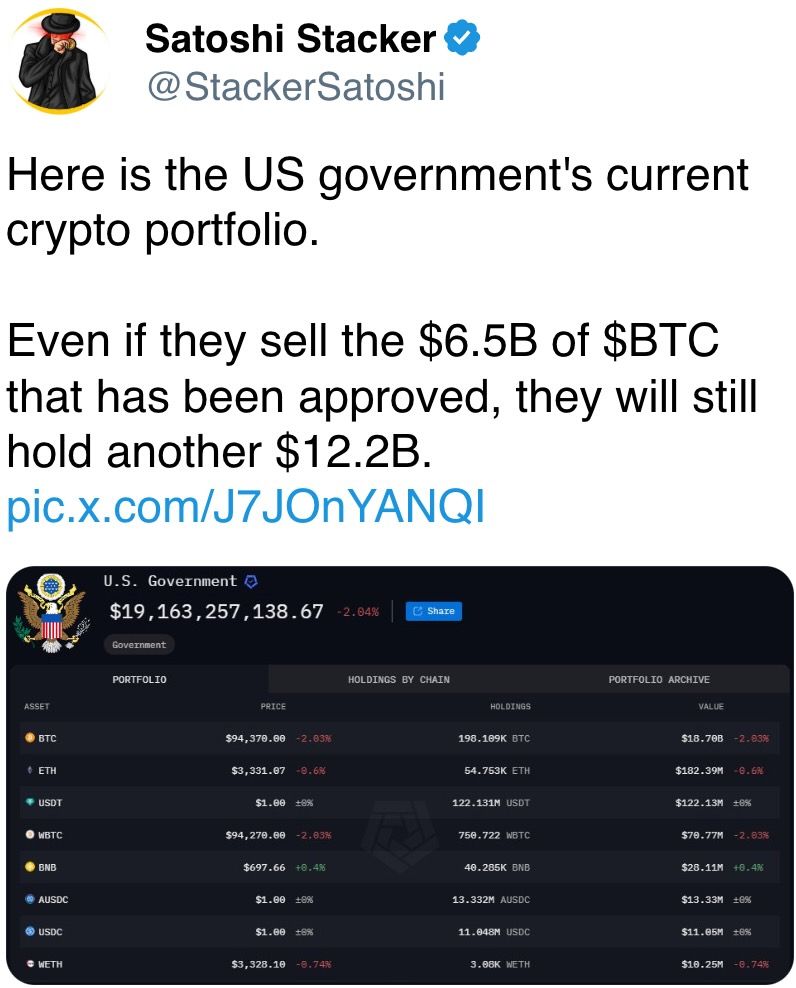

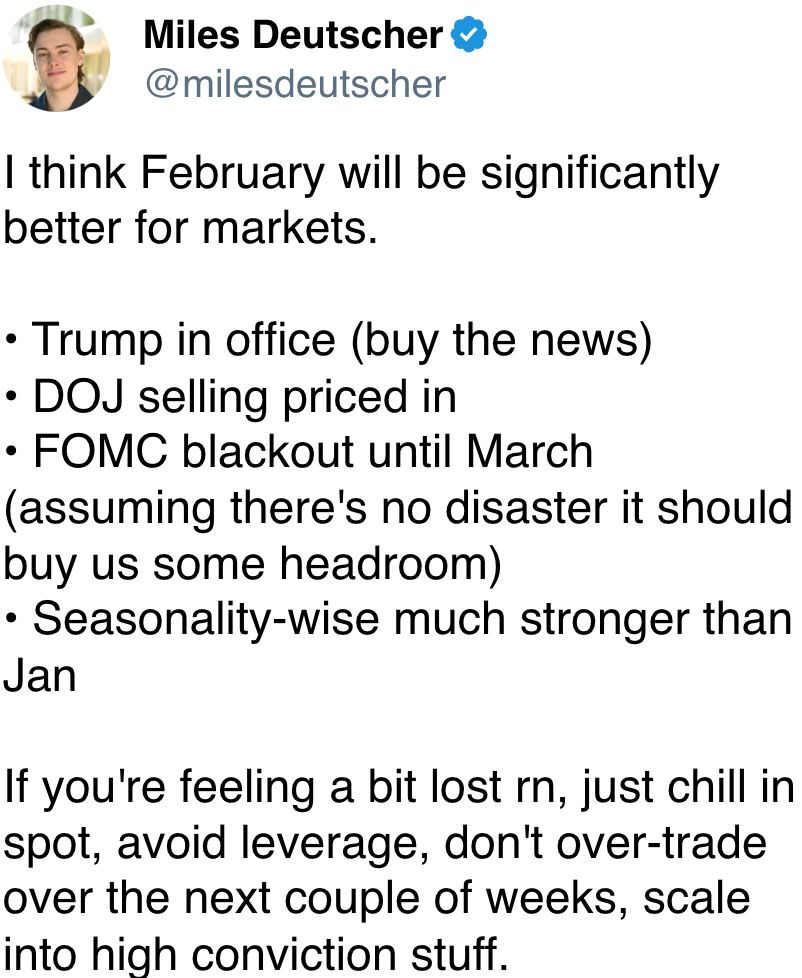
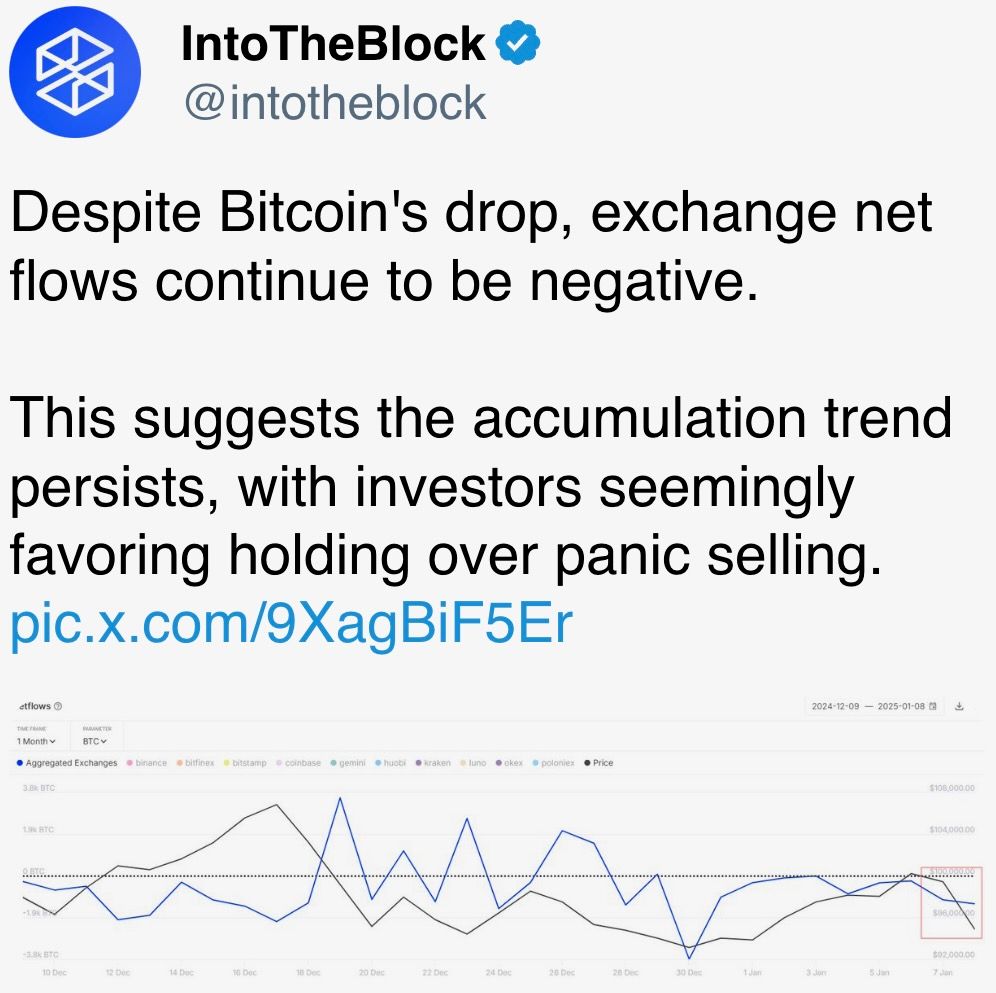
Business
AAVE Sees 64% Flash Crash as DeFi Protocol Endures ‘Largest Stress Test’

The native token of Aave (AAVE), the largest decentralized crypto lending protocol, was caught in the middle of Friday’s crypto flash crash while the protocol proved resilient in a historic liquidation cascade.
The token, trading at around $270 earlier in Friday, nosedived as much as 64% later in the session to touch $100, the lowest level in 14 months. It then staged a rapid rebound to near $240, still down 10% over the past 24 hours.
Stani Kulechov, founder of Aave, described Friday’s event as the «largest stress test» ever for the protocol and its $75 billion lending infrastructure.
The platform enables investors to lend and borrow digital assets without conventional intermediaries, using innovative mechanisms such as flash loans. Despite the extreme volatility, Aave’s performance underscores the evolving maturity and resilience of DeFi markets.
«The protocol operated flawlessly, automatically liquidating a record $180M worth of collateral in just one hour, without any human intervention,» Kulechov said in a Friday X post. «Once again, Aave has proven its resilience.»
Key price action:
- AAVE sustained a dramatic flash crash on Friday, declining 64% from $278.27 to $100.18 before recuperating to $240.09.
- The DeFi protocol demonstrated remarkable resilience with its native token’s 140% recovery from the intraday lows, underpinned by substantial trading volume of 570,838 units.
- Following the volatility, AAVE entered consolidation territory within a narrow $237.71-$242.80 range as markets digested the dramatic price action.
Technical Indicators Summary
- Price range of $179.12 representing 64% volatility during the 24-hour period.
- Volume surged to 570,838 units, substantially exceeding the 175,000 average.
- Near-term resistance identified at $242.80 capping rebound during consolidation phase.
Disclaimer: Parts of this article were generated with the assistance from AI tools and reviewed by our editorial team to ensure accuracy and adherence to our standards. For more information, see CoinDesk’s full AI Policy.
Business
Blockchain Will Drive the Agent-to-Agent AI Marketplace Boom

AI agents, software systems that use AI to pursue goals and complete tasks on behalf of users, are proliferating. Think of them as digital assistants that can make decisions and take actions towards goals you set without needing step-by-step instructions — from GPT-powered calendar managers to trading bots, the number of use cases is expanding rapidly. As their role expands across the economy, we have to build the right infrastructure that will allow these agents to communicate, collaborate and trade with one another in an open marketplace.
Big tech players like Google and AWS are building early marketplaces and commerce protocols, but that raises the question: will they aim to extract massive rents through walled gardens once more? Agents’ capabilities are clearly rising, almost daily, with the arrival of new models and architectures. What’s at risk is whether these agents will be truly autonomous.
Autonomous agents are valuable because they unlock a novel user experience: a shift from software as passive or reactive tools to active and even proactive partners. Instead of waiting for instructions, they can anticipate needs, adapt to changing conditions, and coordinate with other systems in real time, without the user’s constant input or presence. This autonomy in decision-making makes them uniquely suited for a world where speed and complexity outpace human decision-making.
Naturally, some worry about what greater decision-making autonomy means for work and accountability — but I see it as an opportunity. When agents handle repetitive, time-intensive tasks and parallelize what previously had to be done in sequence, they expand our productive capacity as humans — freeing people to engage in work that demands creativity, judgment, composition and meaningful connection. This isn’t make-believe, humanity has been there before: the arrival of corporations allowed entrepreneurs to create entirely new products and levels of wealth previously unthought of. AI agents have the potential to bring that capability to everyone.
On the intelligence side, truly autonomous decision-making requires AI agent infrastructure that is open source and transparent. OpenAI’s recent OSS release is a good step. Chinese labs, such as DeepSeek (DeepSeek), Moonshot AI (Kimi K2) and Alibaba (Qwen 3), have moved even quicker.
However, autonomy is not purely tied to intelligence and decision making. Without resources, an AI agent has little means to enact change in the real world. Hence, for agents to be truly autonomous they need to have access to resources and self-custody their assets. Programmable, permissionless, and composable blockchains are the ideal substrate for agents to do so.
Picture two scenarios. One where AI agents operate within a Web 2 platform like AWS or Google. They exist within the limited parameters set by these platforms in what is essentially a closed and permissioned environment. Now imagine a decentralized marketplace that spans many blockchain ecosystems. Developers can compose different sets of environments and parameters, therefore, the scope available to AI agents to operate is unlimited, accessible globally, and can evolve over time. One scenario looks like a toy idea of a marketplace, and the other is an actual global economy.
In other words, to truly scale not just AI agent adoption, but agent-to-agent commerce, we need rails that only blockchains can offer.
The Limits of Centralized Marketplaces
AWS recently announced an agent-to-agent marketplace aimed at addressing the growing demand for ready-made agents. But their approach inherits the same inefficiencies and limitations that have long plagued siloed systems. Agents must wait for human verification, rely on closed APIs and operate in environments where transparency is optional, if it exists at all.
To act autonomously and at scale, agents can’t be boxed into closed ecosystems that restrict functionality, pose platform risks, impose opaque fees, or make it impossible to verify what actions were taken and why.
Decentralization Scales Agent Systems
An open ecosystem allows for agents to act on behalf of users, coordinate with other agents, and operate across services without permissioned barriers.
Blockchains already offer the key tools needed. Smart contracts allow agents to perform tasks automatically, with rules embedded in code, while stablecoins and tokens enable instant, global value transfers without payment friction. Smart accounts, which are programmable blockchain wallets like Safe, allow users to restrict agents in their activity and scope (via guards). For instance, an agent may only be allowed to use whitelisted protocols. These tools allow AI agents not only to behave expansively but also to be contained within risk parameters defined by the end user. For example, this could be setting spending limits, requiring multi-signatures for approvals, or restricting agents to whitelisted protocols.
Blockchain also provides the transparency needed so users can audit agent decisions, even when they aren’t directly involved. At the same time, this doesn’t mean that all agent-to-agent interactions need to happen onchain. E.g. AI agents can use offchain APIs with access constraints defined and payments executed onchain.
In short, decentralized infrastructure gives agents the tools to operate more freely and efficiently than closed systems allow.
It’s Already Happening Onchain
While centralized players are still refining their agent strategies, blockchain is already enabling early forms of agent-to-agent interaction. Onchain agents are already exhibiting more advanced behavior like purchasing predictions and data from other agents. And as more open frameworks emerge, developers are building agents that can access services, make payments, and even subscribe to other agents — all without human involvement.
Protocols are already implementing the next step: monetization. With open marketplaces, people and businesses are able to rent agents, earn from specialized ones, and build new services that plug directly into this agent economy. Customisation of payment models such as subscription, one-off payments, or bundled packages will also be key in facilitating different user needs. This will unlock an entirely new model of economic participation.
Why This Distinction Matters
Without open systems, fragmentation breaks the promise of seamless AI support. An agent can easily bring tasks to completion if it stays within an individual ecosystem, like coordinating between different Google apps. However, where third-party platforms are necessary (across social, travel, finance, etc), an open onchain marketplace will allow agents to programmatically acquire the various services and goods they need to complete a user’s request.
Decentralized systems avoid these limitations. Users can own, modify, and deploy agents tailored to their needs without relying on vendor-controlled environments.
We’ve already seen this work in DeFi, with DeFi legos. Bots automate lending strategies, manage positions, and rebalance portfolios, sometimes better than any human could. Now, that same approach is being applied as “agent legos” across sectors including logistics, gaming, customer support, and more.
The Path Forward
The agent economy is growing fast. What we build now will shape how it functions and for whom it works. If we rely solely on centralized systems, we risk creating another generation of AI tools that feel useful but ultimately serve the platform, not the person.
Blockchain changes that. It enables systems where agents act on your behalf, earn on your ideas, and plug into a broader, open marketplace.
If we want agents that collaborate, transact, and evolve without constraint, then the future of agent-to-agent marketplaces must live onchain.
Business
‘Largest Ever’ Crypto Liquidation Event Wipes Out 6,300 Wallets on Hyperliquid

More than 1,000 wallets on Hyperliquid were completely liquidated during the recent violent crypto sell-off, which erased over $1.23 billion in trader capital on the platform, according to data from its leaderboard.
In total, 6,300 wallets are now in the red, with 205 losing over $1 million each according to the data, which was first spotted by Lookonchain. More than 1,000 accounts saw losses of at least $100,000.
The wipeout came as crypto markets reeled from a global risk-off event triggered by U.S. President Donald Trump’s announcement of a 100% additional tariff on Chinese imports.
The move spooked investors across asset classes and sent cryptocurrency prices tumbling. Bitcoin briefly dropped below $110,000 and ether fell under $3,700, while the broader market as measured by the CoinDesk 20 (CD20) index dropped by 15% at one point.
The broad sell-off led to over $19 billion in liquidations over a 24 hours period, making it the largest single-day liquidation event in crypto history by dollar value. According to CoinGlass, the “actual total” of liquidations is “likely much higher” as leading crypto exchange Binance doesn’t report as quickly as other platforms.
Leaderboard data reviewed by CoinDesk shows the top 100 traders on Hyperliquid gained $1.69 billion collectively.
In comparison, the top 100 losers dropped $743.5 million, leaving a net profit of $951 million concentrated among a handful of highly leveraged short sellers.
The biggest winner was wallet 0x5273…065f, which made over $700 million from short positions, while the largest loser, “TheWhiteWhale,” dropped $62.5 million.
Among the victims of the flush is crypto personality Jeffrey Huang, known online as Machi Big Brother, who once launched a defamation suit against ZachXBT, losing almost the entire value of his wallet, amounting to $14 million.
«Was fun while it lasted,» he posted on X.
Adding to the uncertainty, the ongoing U.S. government shutdown has delayed the release of key economic data. Without official indicators, markets are flying blind at a time when geopolitical risk is rising.
-

 Business12 месяцев ago
Business12 месяцев ago3 Ways to make your business presentation more relatable
-

 Fashion12 месяцев ago
Fashion12 месяцев agoAccording to Dior Couture, this taboo fashion accessory is back
-

 Entertainment12 месяцев ago
Entertainment12 месяцев ago10 Artists who retired from music and made a comeback
-

 Entertainment12 месяцев ago
Entertainment12 месяцев ago\’Better Call Saul\’ has been renewed for a fourth season
-

 Entertainment12 месяцев ago
Entertainment12 месяцев agoNew Season 8 Walking Dead trailer flashes forward in time
-

 Business12 месяцев ago
Business12 месяцев ago15 Habits that could be hurting your business relationships
-

 Entertainment12 месяцев ago
Entertainment12 месяцев agoMeet Superman\’s grandfather in new trailer for Krypton
-

 Entertainment12 месяцев ago
Entertainment12 месяцев agoDisney\’s live-action Aladdin finally finds its stars





